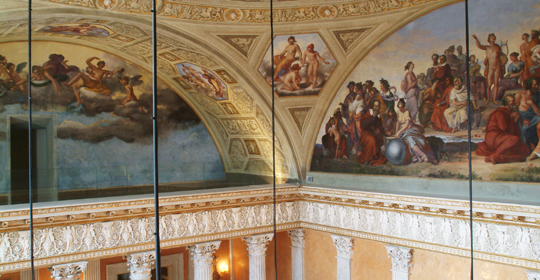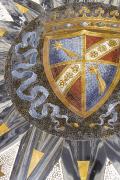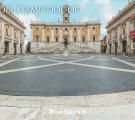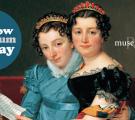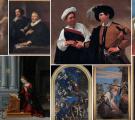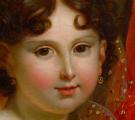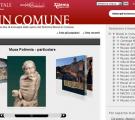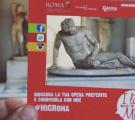1774
Two historical buildings with the walls of Villa Torlonia have been transformed into museum sites: the Casino Nobile, built in the 19th century, now houses the museum that documents the Villa itself as well as a collection of works by the Roman School, and the Museum of the Casina delle Civette, dedicated to artistic stained glass. The Casino dei Principi houses the Roman School Archive, and is used for temporary exhibitions.
The park of the Villa Torlonia contains two museums: the Casino Nobile and the Casina delle Civette (House of the Owls).
The Casino Nobile owes its appearance to the work of Giuseppe Valadier, in about 1802, and, from 1835-1840, that of Giovan Battista Caretti who added the facade’s majestic porch.
Many painters worked on the decoration, among them Podesti and Coghetti, as well as sculptors and plasterers of the schools of Thorvaldsen and Canova.
From 1925 to 1943, the house and grounds were rented to Benito Mussolini. During this time an anti-gas shelter and an anti air-raid bunker were created in the basement.
The restored building holds, on its two display floors, the Museo della Villa, with period sculpture and furnishings. On the second floor is the Museo della Scuola Romana, displaying paintings, sculpture and drawings by the artists of that group.
In the Casino dei Principi, an annex of the Casino Nobile, the Archive of the Scuola Romana, with its rich collection of documents can be consulted. It also periodically hosts temporary exhibitions.
The Casina delle Civette is outstanding in its originality. It was planned in 1839 by the architect Giuseppe Jappelli as a Swiss Cabin; in the early Twentieth Century it was transformed into a ecletic “cottage”, the residence of Prince Torlonia. Its name comes from the recurrent use of owls as an inspiration for the decorative scheme. The numerous multicoloured windows were made, for the most part, by Cesare Picchiarini between 1910 and 1925, from designs by Duilio Cambellotti, Umberto Bottazzi, Vittorio Grassi and Paolo Paschetto.
The building was opened to the public as a museum space in 1997; the original collection has been enriched with other pieces of stained glass by the same craftsmen and with drawings, sketches and preparatory cartoons.
